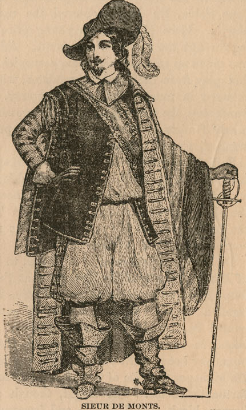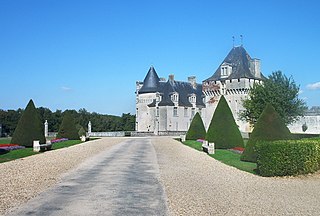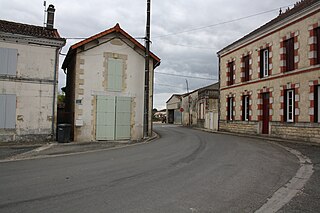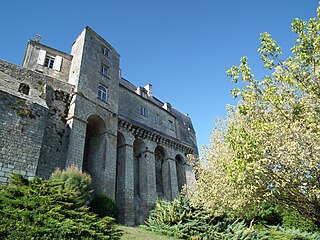
Pierre Dugua de Mons was a French merchant, explorer and colonizer. A Calvinist, he was born in the Château de Mons, in Royan, Saintonge and founded the first permanent French settlement in Canada. He was Lieutenant General of New France from 1603 to 1610. He travelled to northeastern North America for the first time in 1599 with Pierre de Chauvin de Tonnetuit.

Château de la Roche Courbon is a large château, developed from an earlier castle, in the Charente-Maritime département of France. It is in the commune of Saint-Porchaire between Saintes and Rochefort. The château is privately owned, and classified as a historic monument. The garden is listed by the French Ministry of Culture as one of the Notable Gardens of France, and also a historic monument.

The Château de Saint-Germain-en-Laye is a former royal palace in the commune of Saint-Germain-en-Laye, in the département of Yvelines, about 19 km west of Paris, France. Today, it houses the musée d'Archéologie nationale.

The Château de Puivert is a so-called Cathar castle situated in the commune of Puivert, in the Aude département of France. The castle has been classified as a monument historique by the French Ministry of Culture since 1902. This building, on top of a hill overhanging the village and its lake, reaches an elevation of 605 m. The site is in the Quercob region, 60 km (37 mi) south of Carcassonne and 45 km (28 mi) east of Foix.

The Château de Beynac is a castle situated in the commune of Beynac-et-Cazenac, in the Dordogne département of France. The castle is one of the best-preserved and best known in the region.

The Château d'Angoulême was a castle in the town of Angoulême, in the Charente département of France. The only remaining parts are the keep of Lusignan and the tower of Valois, which are part of the Town Hall of Angoulême, together with a construction of the 19th century.

Allas-Champagne is a commune in the Charente-Maritime department in the Nouvelle-Aquitaine region of southwestern France.

The Château de Montignac is a ruined castle in the commune of Montignac-Charente, in the Charente département of France. The castle is the property of the commune and has been listed since 1962 as a monument historique by the French Ministry of Culture.

Ambleville is a former commune in the Charente department in the Nouvelle-Aquitaine region of southwestern France. On 1 January 2022, it was merged into the new commune of Lignières-Ambleville.

Baignes-Sainte-Radegonde is a commune in the Charente department in the Nouvelle-Aquitaine region of south-western France.

Authon-Ébéon is a commune in the Charente-Maritime department in the Nouvelle-Aquitaine region of south-western France.

Pons is a commune in the Charente-Maritime department in southwestern France. The city is known for its numerous national historic monuments dating from the 12th century onward. One of the most well known is the 33 m Keep of Pons, which is the official symbol of the city.

Surgères is a commune in the Charente-Maritime department, southwestern France. It is the home of the Surgères 48 Hour Race.

The Seugne is an 83.3 km (51.8 mi) long river in the Charente-Maritime département, in western France, left tributary of the Charente. Its source is in the commune of Montlieu-la-Garde, 2 km (1.2 mi) west of the village. It flows generally north-northwest.

Crèvecœur Castle is a ruined castle in Belgium. The ruins of the Château de Crèvecœur are located in Bouvignes-sur-Meuse, part of the Belgian city of Dinant, province of Namur, Wallonia. The castle is owned by the Walloon Region. The ruin field can be visited freely all year.

César Phoebus d'Albret, comte de Miossens, was a French soldier, a Marshal of France under Louis XIV, and a court gallant. He was also a cousin of the marquise de Montespan. His faithful attachment to Anne of Austria and Cardinal Mazarin during the Fronde, rather than any military talent, motivated his designation as a marshal of France. He set aside the name of Miossens for the grander name of Albret.

The Château de Verteuil is a historic building in Charente, France. It dates back to 1080 and has since been extensively rebuilt, although 12th-century walls remain. The château has always been in the property of the La Rochefoucauld family.
The canton of Pons is an administrative division of the Charente-Maritime department, western France. Its borders were modified at the French canton reorganisation which came into effect in March 2015. Its seat is in Pons.

The Château de Châtillon-Coligny is a castle, later replaced with a smaller château, in the commune of Châtillon-Coligny in the Loiret département of France.























